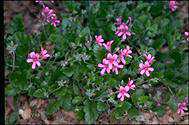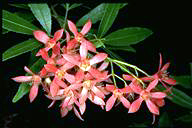

 |
Australian National Botanic Gardens
|
 |
A weekly news sheet prepared by a Gardens' volunteer.
Numbers in square brackets [] refer to garden bed Sections.
Plants in flower are in bold type.
12 March 2004
 |
|
Pelargonium rodneyanum
- click for larger image
|
On leaving the Information Centre look at the group of pot plants on either side of the door. On your right-hand side is Acacia fauntleroyi and across on the left is Pandorea ‘Southern Bell’. There are other small plants in flower there too. Keep to the left and go down the steps to see Allocasuarina inophloia [Section 212], presently shedding its bark and giving it the hairiest tree trunk one could ever see! The Lomandra longifolia [Section 212], with their strap-like leaves and tightly spaced, spiny yellow flowers provides quite a contrast to the surroundings. Take the path towards the grasses area and a small prostrate Pelargonium rodneyanum [Section 222], with charming, mauve flowers, seems intent on taking over the small garden bed. Cross the road to the Grassy Woodland, easily seen is the group of four Xanthorrhoea glauca subsp. glauca [Section 175], and a little further on is the grass Danthonia pencillata [Section 175], it likes moist, shady places and blends in well with the plants around it. Before crossing the road, do read the notice explaining the Grassy Woodland. The small pathway has growing on either side Melaleuca ‘Velvet cushion’, not in flower but the bushes certainly define the path. Turn the corner, and the Mountain Devil, Lambertia formosa, [Section 170], is easily seen with its orange coloured flowers held at the end of its stems.
 |
|
Ceratopetalum gummiferum
- click for larger image
|
In the Tasmanian Flora Section, Leptospermum grandiflorum [Section 170], has only a few of its white to pink flowers out, while Acacia pataczekii [Section 170], is sprawling across the garden bed with some of its leaves already turning red, but with white flowers as well! Cross the small bridge on the left where Gunnera cordifolia [Section 230] is a tiny ground cover plant, growing to the very edge of the pond and, further on, on the opposite side of the path is Chrysocephalum apiculatum [Section 230], with its tiny yellow flowers. On the right is another small ground cover, Ranunculus glabrifolius, not in flower but another very successful ground cover. On the right look for Eucalyptus vernicosa [Section 231], a small plant nearly a metre tall and surely is one of the slowest growing of all the gums! Another tiny prostrate plant is Velleia montana [Section 232], the exceedingly tiny yellow flowers each dotted with an even smaller green center. There is another notice with information on ‘Tasmanian Mountain Habits’ as well as the Lowland and Valley Habitats. The Nothofagus cunninghamii [Section 235] had the sun shining on its tiny green leaves turning them almost to silver! Lots to see here.
Follow the path skirting the car park where a group of New South Wales Christmas Bush, Ceratopetalum gummiferum [Section 66], are well past their flowering but all showing off their bright red bracts. Then to the main walk, where at the corner are four clumps of Crowea ‘Festival’ [Section 174], eye caching with the dainty, star shaped mauve flowers. Admire the three lovely Macrozamia mooorei, [174] providing protection for some of the smaller plants around them, while at the corner, near the Joseph Banks statue is a large bush of Prostanthera florifera [Section 174], with its white petals, brown centers and definite green leaves against a background of brown stalks. Lovely!
Enjoy! Naomi Bell